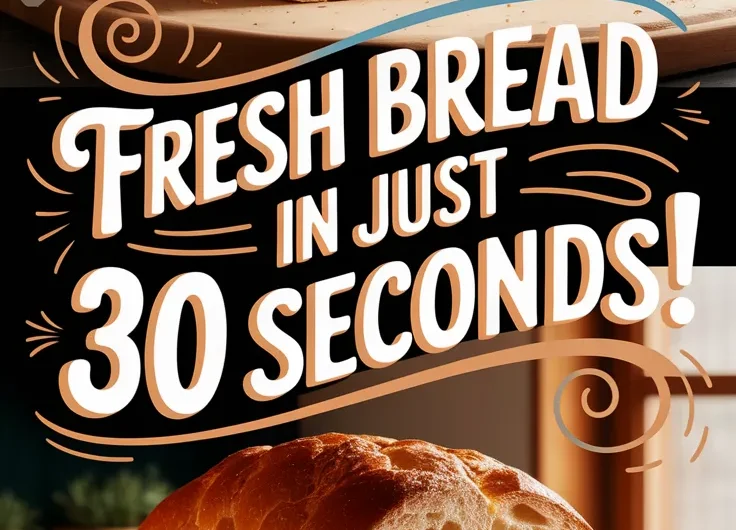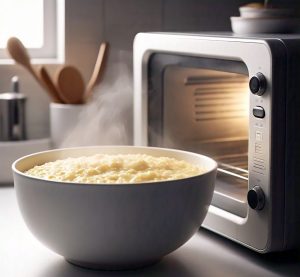Toss that sad, stiff loaf? Not so fast! We’ll show you how to rescue stale bread in 30 seconds flat using a microwave and a damp paper towel. No fancy gadgets or oven preheating required—just instant softness.
This trick works on baguettes, sandwich slices, and even crusty rolls. You’ll save money, reduce food waste, and avoid that depressing “cardboard” texture forever.
Below, we break down every step, troubleshoot soggy mishaps, and share pro storage tips. Let’s turn your rock-hard bread into a warm, pillowy delight.
Jump To:
Revive Stale Bread in 30 Seconds with a Wet Paper Towel
Recipe by Lisa MartinCourse: SnackCuisine: Various1
1
minute50
kcal1
minuteStale bread doesn’t have to go to waste! With this quick and easy microwave method, you can bring stale bread back to life. By using a wet paper towel, you can steam the bread in the microwave, making it soft and fresh in seconds. This is perfect for when you want to make a sandwich or enjoy a slice of toast without the hassle of baking fresh bread.
Ingredients
of stale bread
paper towel.
Directions
- Take a slice of stale bread and wrap it in a damp paper towel
- Place the wrapped bread on a microwave-safe plate
- Microwave on high for 10-30 seconds, checking at the 10-second mark to see if it feels soft
- Once softened, remove it from the microwave and unwrap it carefully
- Let it cool for a moment before enjoying your revived bread.
Notes
- Make sure the paper towel is damp but not dripping wet to prevent sogginess. You can repeat the microwave process if the bread is still not soft enough, but be cautious not to overheat it, as that can make it tough or chewy. This method works best for slices of bread and can restore the texture remarkably well.
Can You Microwave Stale Bread?
Absolutely! Microwaving is our secret weapon against stale bread. The moist heat rehydrates dried-out starches, reviving that fresh-baked softness. My dad George once salvaged a rock-hard sourdough boule at a family BBQ this way—our pulled pork sandwiches were saved!
Just avoid nuking breads with sugary glazes or delicate textures (looking at you, croissants). The microwave’s intensity can turn sticky toppings into molten lava or make flaky layers collapse faster than a toddler’s block tower.
How to Revive Stale Bread in 30 Seconds With a Wet Paper Towel
We’ve tested this method on everything from ciabatta to gluten-free sandwich loaves. Follow these steps to transform your bread from hockey puck to heavenly in half a minute. If you’re looking for a quick and simple way to enjoy fresh bread, consider trying a microwave bread recipe. It’s a convenient option for those busy days when you need homemade bread in a flash.
Step 1: Wrap Bread in Damp Paper Towel
Run a paper towel under cool water and wring it out until damp—not dripping. Wrap it snugly around the bread like a cozy blanket. Pro tip: For crusty breads, wrap the towel around the cut surface only to preserve that crispy exterior. Additionally, putting a paper towel in the microwave can help keep your food moist and prevent splattering. This simple trick can enhance your microwave cooking experience.
Step 2: Use a Microwave-safe Plate
Place your bundled bread on a ceramic or glass plate. Never use metal accents or plastic containers—we once melted a “microwave-safe” silicone mat that now lives as modern art in our junk drawer. It’s essential to ensure that any plastic items used in the microwave are certified as microwave-safe. Otherwise, it can lead to similar mishaps in the future.
Step 3: Microwave for 10-30 Seconds
Start with 10 seconds for thin slices, 20-30 for thicker chunks. Our tests show 15 seconds revives 90% of sandwich breads. Heavier artisan loaves might need 25 seconds—think of it as bench pressing for your microwave. For example, flax bread tends to be denser and benefits from a bit more time.
Step 4: Check Texture & Repeat if Needed
Unwrap carefully (steam alert!) and press the center. If it feels dense or cool, rewrap and microwave in 5-second bursts. Our record? Three cycles for a fossilized bagel found behind the coffee beans.
Common Mistakes & Fixes
- Soggy bread? Your towel was too wet. Next time, wring harder—imagine you’re squeezing out a grudgy dish sponge.
- Chewy crust? Over-nuked! Let bread sit unwrapped for 1 minute to re-crisp.
- Cold spots? Rotate the bread 180° before reheating. Microwaves have favorite corners like toddlers with chicken nuggets.
Now that you’re a bread revival pro, let’s talk about choosing the right loaf and tools for microwave magic. Experimenting with quick recipes can lead you to delicious creations, like a copycat Starbucks banana bread microwave loaf. This easy and convenient treat brings that popular café flavor right to your home in a fraction of the time.
Ingredients & Tools for Microwave Revival
You only need three things: stale bread, a damp paper towel, and a microwave-safe plate. My college roommate once tried reviving rye toast on a frisbee—let’s just say melted plastic smells nothing like caraway seeds. One clever application of these items is making quick microwave bread, which can turn that stale loaf into a soft, warm treat in just a few minutes.
Bread Type Alternatives
This trick works best on breads with sturdy crumb structures (the air pockets inside). Think: When baking bread in a microwave, it’s important to consider how the process affects these key structural features. Learning the right techniques can allow you to achieve fluffy, tasty bread without needing a traditional oven.
- Baguettes
- Sourdough boules
- Ciabatta
- Whole grain sandwich bread
Avoid ultra-soft or sweet breads like brioche or Hawaiian rolls. Their high fat/sugar content can lead to gummy textures. I learned this the hard way reviving cinnamon raisin bread that turned into edible glue. For a better baking experience, consider exploring cinnamon sugar milk bread and using microwave proofing techniques. This approach can help achieve a light and fluffy texture that complements the sweetness of the bread.
Paper Towel Substitutes
Out of paper towels? Try:
- Clean cotton napkins (lint-free)
- Unbleached coffee filters
- Damp lettuce leaves (for a crispy-wrap hack)
Skip wax paper or aluminum foil—they block steam. My aunt once used a polyester tea towel that fused to her focaccia. We still find glittery threads in her bread basket. However, if you ever consider using aluminum foil in the microwave, it’s crucial to do so carefully. Properly using aluminum foil can help with heat distribution, but it must be done right to avoid dangerous sparks.
Also See: Rice Krispie Treats Recipe in Microwave – 5 Variations, Tips, Tools, FAQs & More
How to Store Revived Bread
Revived bread tastes best immediately, but if you must save it:
Short-term Storage Solutions
- Bread box: Keeps slices airy for 4-6 hours
- Airtight container: Prevents re-staling for 8 hours max
- Foil wrap: Maintains softness without sogginess
Never refrigerate! Cold temps accelerate starch retrogradation (that’s science-speak for “turning bread into drywall”). If you won’t eat it within 12 hours, freeze it in a sealed bag—thaw later with another 10-second microwave zap.
Ready to explore more ways to rescue bread? Let’s dive into oven tricks and skillet hacks…
Also See: Easy Caprese Salad With Microwave Balsamic Glaze

Now It’s Your Turn to Try!
We’ve walked you through every step of reviving stale bread in just 30 seconds using a wet paper towel. From proper wrapping techniques to troubleshooting common mistakes, you’re fully equipped to bring that loaf back to life.
Give this method a shot next time your bread loses its freshness – we bet you’ll be amazed at how well it works. Just remember: 10-30 seconds is the sweet spot, and always check between bursts to avoid overdoing it!




